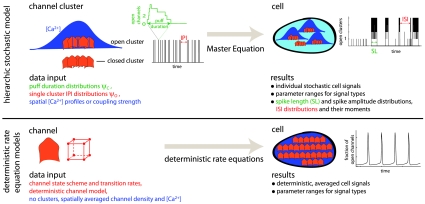Fig. 1.
Summary of the modeling concept and comparison with traditional concepts. The stochastic hierarchic model takes advantage of the structural and functional hierarchy formed by channels, channel clusters, and the cell. It subsumes the dynamics of the lower structural level into waiting time distributions on the next higher one. Channels cause the IPI distribution ψo and puff duration distributions ψc of clusters, and clusters generate the ISI and spike length (SL) distributions on cell level. The waiting time distributions on cluster level can be measured in vivo. That circumvents the problems arising from using parameter values from in vitro experiments for cell simulations, as deterministic rate equation models usually do. The involvement of many channels is required for the validity of rate equation models, such that average deterministic dynamics apply. Therefore, they are based on the assumption of continuous channel densities neglecting channel clustering. The additional assumption of fast Ca2+ diffusion entails neglecting spatial gradients and a mathematical description of cell behavior by ordinary differential equations. But this is in contradiction to the steep concentration gradients occurring during Ca2+ release. See SI Text for details.

